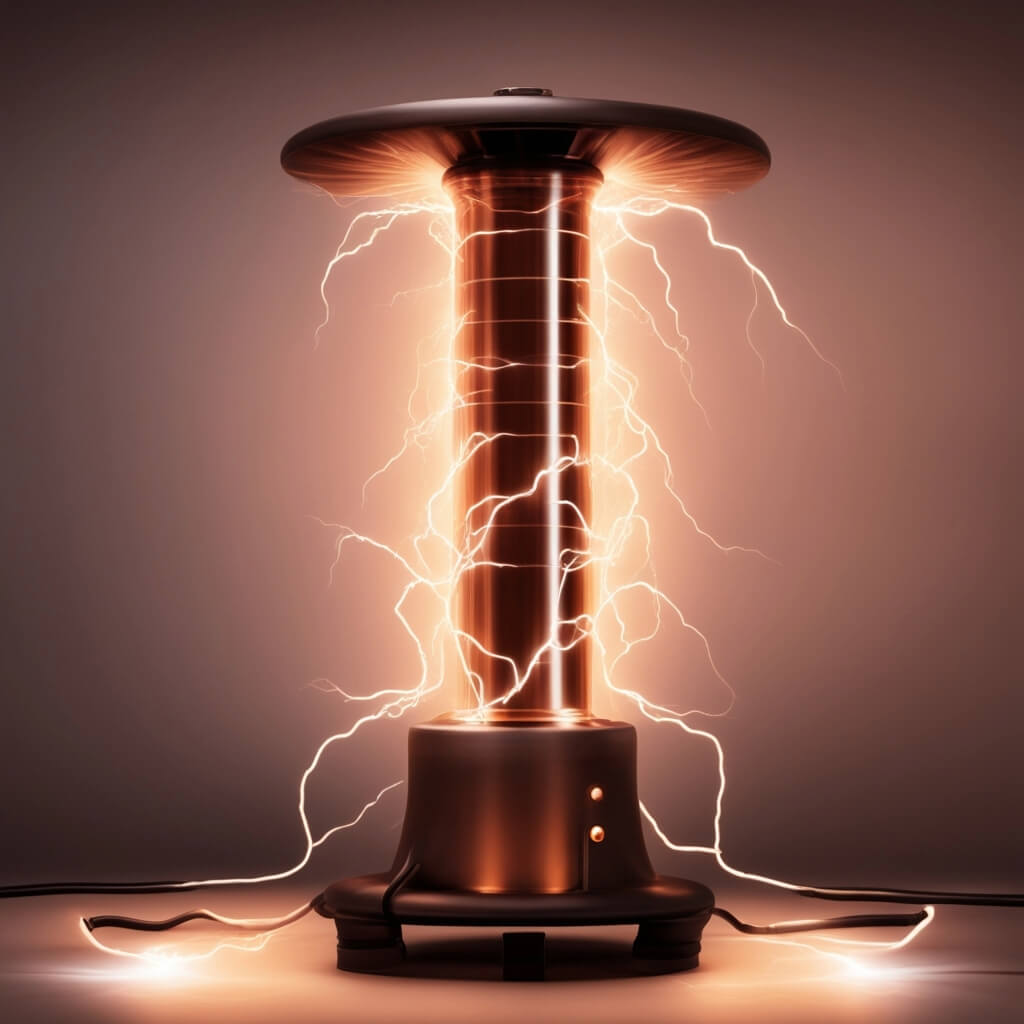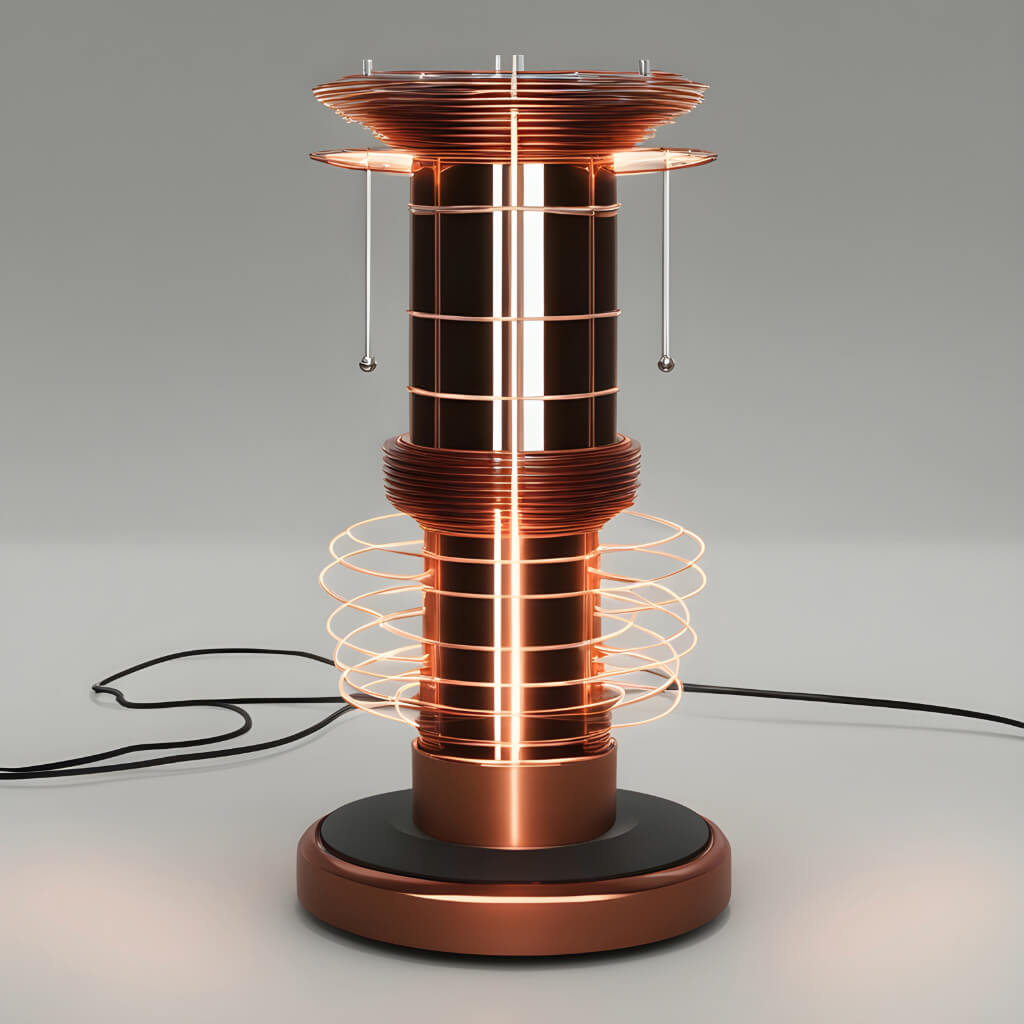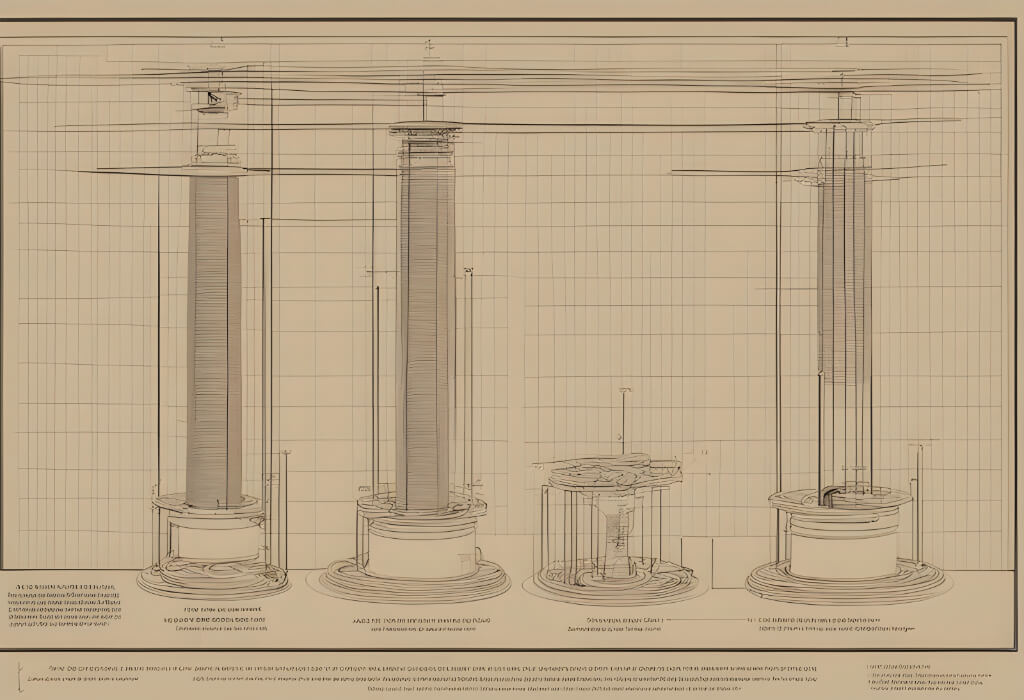The mesmerizing hum of electricity, the crackle of energy in the air—these are the sensations that accompany the fascinating phenomenon known as the Tesla coil. In this article, we will embark on a journey through the history, workings, applications, and safety considerations of this remarkable invention.

How Tesla Coil Works
At its core, the Tesla coil operates on intricate principles. The key lies in resonant frequency, a phenomenon where the coil’s circuit vibrates in harmony with an external energy source. This resonance, coupled with the transformer action and capacitor discharge, creates mesmerizing electrical arcs.
The components of a Tesla coil work in harmony to produce these captivating displays. The primary coil, secondary coil, spark gap, and capacitor all play pivotal roles in channeling and amplifying the electrical energy. The result is a visually stunning spectacle of sparks and lighting.
Nikola Tesla’s Contribution
No exploration of the Tesla coil is complete without acknowledging the brilliance of its namesake—Nikola Tesla. A pioneer in electrical engineering, Tesla’s inventions and innovations laid the groundwork for many modern technologies. The Tesla coil, a crucial component of his work, stands as a testament to his visionary contributions.
Types Of Tesla Coils
Over the years, Tesla coils have evolved into various types, each with its unique characteristics. Solid-state Tesla coils, rotary spark gap Tesla coils, micro and mini Tesla coils—these variations cater to different purposes and audiences. The diversity in types allows enthusiasts to explore and experiment with Tesla coil technology.
Applications
The versatility of Tesla coils extends beyond the realm of scientific experiments. They find an entertainment place, where Tesla coil concerts and light shows captivate audiences with their dazzling displays. In educational settings, Tesla coils serve as powerful teaching tools, offering hands-on demonstrations in physics classrooms and inspiring DIY projects.
Scientific research benefits from Tesla coils as well, contributing to our understanding of electricity and electromagnetic fields. The applications of Tesla coils are as diverse as the coils themselves, showcasing their adaptability in various fields.
Safety Considerations
While the allure of Tesla coils is undeniable, it is crucial to approach them with caution. The high voltage associated with these devices poses inherent risks. Enthusiasts must take protective measures, including proper insulation and grounding, to ensure safe operation. Understanding and adhering to safety guidelines is paramount for those eager to harness the power of Tesla coils.
Notable Tesla Coil Projects
Tesla coils have left an indelible mark on popular culture. From being featured in music performances to starring in iconic movies, the Tesla coil’s influence is widespread. Some of the largest Tesla coils ever built stand as engineering marvels, pushing the boundaries of what is possible with this captivating technology.
Future Developments
As technology advances, so does the potential of Tesla coil applications. Ongoing research aims to unlock new possibilities, further expanding the role of Tesla coils in scientific, entertainment, and educational domains. The future promises exciting developments, hinting at innovations that will continue to shape the landscape of electrical engineering.
The Tesla coil remains a symbol of ingenuity and scientific exploration. From its humble beginnings to its current diverse applications, the Tesla coil continues to captivate and inspire. Its enduring legacy, coupled with ongoing advancements, ensures that this marvel of electrical engineering will shine brightly in the years to come.
A Comprehensive Guide To Homemade Tesla Coil Designs
Nikola Tesla, the brilliant mind behind numerous groundbreaking inventions, left an indelible mark on the world of electricity. Among his many creations, the Tesla coil stands out as an emblem of his genius. In this article, we delve into the fascinating realm of homemade Tesla coil designs, offering enthusiasts and hobbyists a comprehensive guide to constructing their electrifying apparatus.
Understanding Tesla Coils
At the heart of every Tesla coil lies a complex interplay of components, each with a specific role to play. The primary coil, secondary coil, capacitor, and spark gap work in harmony to produce mesmerizing electrical discharges. Understanding these elements is crucial for anyone venturing into the realm of homemade Tesla coil designs. With a solid grasp of the basic principles of operation, enthusiasts can embark on their journey with confidence, knowing the intricacies of their creation.
Tools And Materials
Embarking on a homemade Tesla coil project requires more than just enthusiasm; it demands the right tools and materials. From soldering irons to wire cutters, assembling a comprehensive toolkit is essential. Equally important is sourcing quality materials for construction, ensuring the longevity and performance of the final product. Whether scavenging for components or purchasing them online, diligent research can make all the difference in achieving success with homemade Tesla coil designs.
Types Of Tesla Coils
Homemade Tesla coil designs come in various shapes and sizes, each with its unique characteristics. Traditional spark gap Tesla coils evoke a sense of nostalgia, while solid-state variants offer modern efficiency and control. Miniature coils cater to space-conscious enthusiasts, whereas large-scale projects promise awe-inspiring displays of electrical prowess. With options ranging from Slayer exciters to musical Tesla coils, there’s a design suited to every level of expertise and ambition.
Design Considerations
Crafting a homemade Tesla coil requires careful consideration of design parameters to achieve optimal performance. Determining coil size, calculating resonant frequency, and adjusting parameters are pivotal steps in the construction process. By fine-tuning these elements, enthusiasts can unlock the full potential of their creations, ensuring maximum efficiency and output power. Experimentation is key, allowing builders to refine their designs and push the boundaries of possibility in homemade Tesla coil designs.
Step-By-Step Construction Guide
Armed with knowledge and tools, it’s time to roll up your sleeves and embark on the construction journey. Building the primary coil, constructing the secondary coil, assembling the capacitor bank, and setting up the spark gap are all integral steps in bringing homemade Tesla coil designs to life. With each component carefully crafted and connected, enthusiasts can witness the gradual realization of their electrifying vision. Testing and troubleshooting along the way ensure a smooth transition from blueprint to reality.

Fine-Tuning And Optimization
Homemade Tesla coil designs are not static entities but dynamic creations that evolve through experimentation and optimization. Fine-tuning coil configurations, adjusting turns, and optimizing spark gap settings are ongoing processes that yield incremental performance improvements. By incorporating feedback systems and embracing iterative design principles, enthusiasts can continually refine their creations, pushing the boundaries of what’s possible in the realm of homemade Tesla coil designs.
Safety Precautions And Best Practices
Amidst the excitement of construction, safety should always remain a top priority. Proper grounding, insulation, and handling of high voltage are non-negotiable aspects of working with Tesla coils. Protective gear and adherence to best practices mitigate risks and ensure a safe working environment. For beginners, supervision and guidance are invaluable assets, providing reassurance and guidance as they navigate the intricacies of homemade Tesla coil designs.
Applications And Fun Projects
Beyond the realm of experimentation, homemade Tesla coil designs find applications in a myriad of fields. From demonstrating wireless energy transfer to creating captivating light and sound displays, the possibilities are limited only by imagination. Educational institutions and science enthusiasts alike find value in homemade Tesla coil projects, inspiring curiosity and innovation. As enthusiasts share their creations and experiences, they contribute to a vibrant community united by a passion for homemade Tesla coil designs.
In the pursuit of homemade Tesla coil designs, enthusiasts embark on a journey fueled by curiosity, creativity, and a thirst for knowledge. From humble beginnings to awe-inspiring displays, each project represents a testament to human ingenuity and the enduring legacy of Nikola Tesla. As enthusiasts continue to push the boundaries of what’s possible, the spark of innovation ignites anew, illuminating the path forward in the electrifying world of homemade Tesla coil designs.
Tesla Coil Experiments For Beginners
Embarking on the journey of Tesla coil experiments for beginners is an exhilarating endeavor. These electrifying devices, pioneered by Nikola Tesla, have captivated enthusiasts for decades with their dazzling displays of high-voltage arcs and wireless energy transfer. In this article, we’ll delve into the world of Tesla coil experiments, offering novice enthusiasts a comprehensive guide to conducting their electrifying experiments.
Understanding Tesla Coils
Before diving into Tesla coil experiments for beginners, it’s essential to understand the basic principles behind these fascinating devices. Tesla coils consist of primary and secondary coils, a capacitor, and a spark gap. The primary coil is connected to a power source, creating an oscillating magnetic field that induces a high voltage in the secondary coil. The capacitor stores energy, while the spark gap allows for the release of electrical energy in the form of spectacular arcs.
Getting Started With Experiments
For beginners, embarking on Tesla coil experiments can be both exciting and daunting. Start by familiarizing yourself with the components of the Tesla coil and their functions. Once you have a basic understanding, you can begin with simple experiments, such as lighting up fluorescent bulbs wirelessly or creating miniature lightning bolts using a pointed object. These initial experiments will help you gain confidence and understanding before moving on to more advanced Tesla coil experiments for beginners.
Safety First
Safety should always be the top priority when conducting Tesla coil experiments, especially for beginners. High voltages and electrical currents pose serious risks, so it’s crucial to take precautions. Wear protective gear such as gloves and safety goggles, and work in a well-ventilated area. Keep flammable materials away from the Tesla coil, and never touch the coil or its components while it’s in operation. With proper safety measures in place, you can enjoy conducting Tesla coil experiments safely.
Exploring Wireless Energy Transfer
One of the most fascinating aspects of Tesla coil experiments is wireless energy transfer. Tesla envisioned a world where electricity could be transmitted wirelessly, and his coils demonstrate this principle beautifully. Beginners can conduct simple experiments to demonstrate wireless energy transfer by lighting up fluorescent bulbs placed near the Tesla coil. As you gain confidence, you can explore more advanced experiments, such as powering electronic devices wirelessly or even lighting up a bulb from a distance.
Creating Spectacular Light Shows
Tesla coil experiments aren’t just educational—they’re also incredibly entertaining. Beginners can create dazzling light shows by connecting the Tesla coil to various objects, such as metal rods or spheres. As the Tesla coil generates high-voltage arcs, they will ionize the air around them, creating brilliant displays of light. Experiment with different objects and configurations to create mesmerizing patterns and effects.
Embarking on Tesla coil experiments for beginners is an exciting journey into the world of high-voltage physics and electrical engineering. By starting with simple experiments and gradually building your skills and knowledge, you can unlock the full potential of these electrifying devices. With proper safety measures in place, you can safely explore wireless energy transfer, create spectacular light shows, and gain a deeper understanding of Tesla coil technology.
Tesla Coil Voltage Control Techniques
Tesla coils, with their spectacular displays of electrical arcs and sparks, are marvels of engineering. However, to harness their full potential safely and effectively, mastering voltage control is essential. In this article, we’ll explore various techniques for regulating voltage in Tesla coils, enabling enthusiasts to achieve precise control over their electrical creations.
Understanding Tesla Coil Voltage
Voltage is the lifeblood of Tesla coils, driving the generation of high-frequency electrical discharges. Understanding how voltage affects coil performance and safety is fundamental. By grasping the principles of voltage regulation, builders can ensure their Tesla coil voltage control techniques yield optimal results.

Primary Coil Adjustment
One of the fundamental Tesla coil voltage control techniques is adjusting the primary coil. By varying the number of turns in the primary coil, builders can regulate the amount of energy transferred to the secondary coil. This adjustment directly impacts the voltage output of the Tesla coil, allowing for fine-tuning of its performance.
Capacitor Bank Configuration
Another crucial aspect of voltage control lies in configuring the capacitor bank. The capacitor bank stores and releases electrical energy during the tesla coil’s operation. By adjusting the size and arrangement of capacitors within the bank, builders can influence the voltage output of the coil. Careful selection and arrangement of capacitors are vital for achieving precise voltage control.
Spark Gap Optimization
Spark gaps play a significant role in voltage regulation within Tesla coils. By adjusting the distance between electrodes and the characteristics of the gap, builders can control the breakdown voltage required for electrical discharge. Spark gap optimization is essential for maintaining stable voltage output and preventing arcing or damage to the coil.
Secondary Coil Tuning
Tuning the secondary coil is another effective strategy for Tesla coil voltage control techniques. By adjusting parameters such as coil length, diameter, and number of turns, builders can influence the voltage amplification process. Fine-tuning the secondary coil allows for precise control over the voltage output of the Tesla coil.
Solid-State Alternatives
In recent years, solid-state Tesla coil designs have emerged as viable alternatives to traditional spark gap coils. These solid-state configurations offer advanced voltage control capabilities, allowing for precise regulation of output voltage. Exploring solid-state alternatives provides builders with additional options for implementing Tesla coil voltage control techniques.
Feedback Systems Implementation
Implementing feedback systems is a sophisticated approach to Tesla coil voltage control techniques. By integrating feedback mechanisms into the coil’s design, builders can achieve stable and precise voltage regulation. These systems continuously monitor and adjust coil parameters to maintain optimal performance and prevent voltage fluctuations.
Safety Considerations
While experimenting with Tesla coil voltage control techniques, safety must always remain a top priority. High voltages present inherent risks, and builders must take precautions to mitigate them. Proper insulation, grounding, and the use of protective gear are essential to ensure safe experimentation with Tesla coils.
Practical Applications
The mastery of Tesla coil voltage control techniques opens up a world of practical applications. From educational demonstrations to artistic installations, precise voltage regulation enables builders to unleash the full potential of their Tesla coils. Exploring innovative applications of voltage-controlled Tesla coils inspires creativity and pushes the boundaries of what’s possible in electrical engineering.
Final Thoughts
In mastering Tesla coil voltage control techniques, enthusiasts unlock new possibilities for experimentation and innovation. By understanding and implementing various voltage control strategies, builders can achieve precise control over their Tesla coils’ performance. Embracing safety practices and exploring practical applications enriches the journey of Tesla coil experimentation.
FAQs
Can I Build A Tesla Coil At Home?
Building a Tesla coil at home is possible, but it requires a deep understanding of electrical principles and safety measures. It is recommended to follow reputable guides and take necessary precautions to avoid potential hazards.
Are Tesla Coils Used For Anything Other Than Entertainment?
Yes, Tesla coils have applications beyond entertainment. They are used in educational settings for physics demonstrations, scientific research for studying electromagnetic fields, and even in artistic projects.
Are Tesla Coil Performances Safe To Attend?
When conducted by professionals who adhere to safety standards, Tesla coil performances are generally safe to attend. It is crucial to follow event guidelines and stay within designated safety zones.
What Is The Largest Tesla Coil Ever Built?
The largest Tesla coil ever built is a subject of ongoing competition among enthusiasts. Various large-scale installations worldwide vie for the title, showcasing the continuous innovation in Tesla coil technology.
Are Homemade Tesla Coils Dangerous To Build And Operate?
While Tesla coils can generate high voltages and pose risks if mishandled, adhering to safety protocols and best practices mitigates potential dangers. Beginners should seek guidance and supervision when undertaking homemade Tesla coil projects.
Can I Use Readily Available Components For My Homemade Tesla Coil Designs?
Yes, many of the components required for Tesla coil construction can be sourced from electronics stores or online retailers. However, it’s essential to ensure the quality and compatibility of components for optimal performance.
What Are Some Common Troubleshooting Issues Encountered During Tesla Coil Construction?
Common issues include inadequate insulation leading to arcing, improper tuning resulting in low efficiency, and component failures due to overheating or overvoltage. Thorough testing and systematic troubleshooting can help identify and resolve these issues effectively.
Are Tesla Coil Experiments Safe For Beginners?
While Tesla coil experiments can be conducted safely with proper precautions, beginners should be aware of the risks associated with high voltages and electrical currents. Always wear protective gear and work in a well-ventilated area to minimize risks.
What Are Some Easy Tesla Coil Experiments For Beginners To Try?
Beginners can start with simple experiments such as lighting up fluorescent bulbs wirelessly or creating miniature lightning bolts using a pointed object. These experiments help build confidence and understanding before moving on to more advanced projects.
Can I Conduct Tesla Coil Experiments Indoors?
While Tesla coil experiments can be conducted indoors, it’s essential to work in a well-ventilated area and keep flammable materials away from the Tesla coil. Additionally, be mindful of the space needed for safety and to avoid interference with electronic devices.
Are Tesla Coil Voltage Control Techniques Difficult To Master?
While Tesla coil voltage control techniques require understanding and practice, enthusiasts can gradually master them through experimentation and learning from experienced builders.
Can I Implement Voltage Control Techniques In My Existing Tesla Coil Design?
Yes, many voltage control techniques are adaptable to existing Tesla coil designs. However, it’s essential to carefully assess compatibility and safety considerations before making modifications.
Also Read: Unveiling The Hidden Stories Of Nobel Prize Winners
